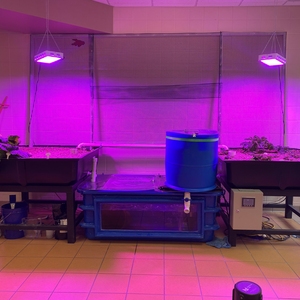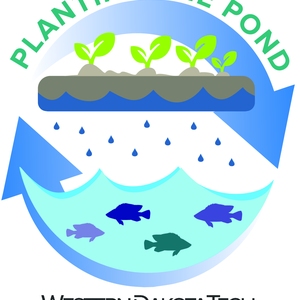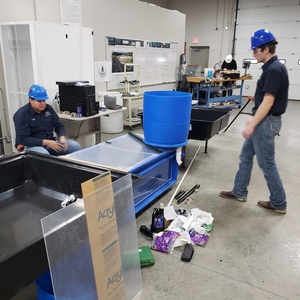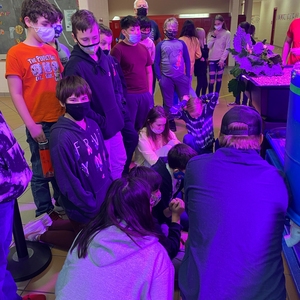Planting the Pond
Western Dakota Technical College
Project Overview
For this project, Western Dakota Tech formed an interdisciplinary team comprised of Environmental Engineering, Controlled Environment Agriculture, Electrical Trades, Computer-Aided Design, and Farm and Ranch Management students to design and build an aquaponics system, along with curriculum, to be used Middle School Education. Through this project, WDT technical trades students gained necessary skills in their respective trades while simultaneously benefiting K12 students and the community.
Aquaponics is a synergistic food production platform that combines techniques in aquaculture and hydroponics to simultaneously raise edible plants and fish. As a forward-looking technology, aquaponics responds to the current sustainability challenges of the 21st century, including limited arable land, constrained freshwater supplies, soil degradation, and soil nutrient depletion, by minimizing water use and negative environmental impacts. It uses biomimicry of ecosystem services, including nutrient and water cycling, that occur naturally in lakes and rivers. By creating a symbiosis among plants, fish, and microorganisms, water and nutrient reuse is maximized, and environmental impacts are minimized. Over the past decade, there has been growing interest in aquaponics on a global scale, as it has the capacity to be an important driver for the development of sustainable food sources. It is advantageous in that it produces two cash crops (plants, fish) simultaneously, so it has shared startup and operating and infrastructure costs. Additionally, aquaponics technology can be used to produce food closer to urban centers as a solution to food deserts, or it can be implemented in rural areas as an innovative response to food scarcity (which, unfortunately is common in our geographic region).
Background
In 2018, the National Science Foundation (NSF) and the American Association of Community Colleges (AACC) awarded a team from Western Dakota Technical Institute (WDT) in Rapid City, SD, first place in the fourth annual Community College Innovation Challenge. The winning project, entitled “Electrical Automation to Solve World Hunger,” used an aquaponics system as a tool for both the technical training of Trades professionals as well as the broader goal of solving the local, regional, and national problem of food insecurity. The project involved building an integrated aquaponics prototype, and its successors Aqua 2.0 and 2.1, where Programmable Logic Control (PLC) systems were designed, tested, and implemented. The resulting units were mini ecosystems that could generate organic fish and vegetables with minimal user involvement and minimal resource inputs. This innovative combination of electrical expertise with environmental engineering has not only captured the attention of the NSF but has garnered significant regional interest in Western South Dakota.
In spring 2019, WDT hosted “Aqua 3.0,” an internal engineering design competition for students in Environmental Engineering, Electrical Trades, and Computer-Aided Design. Multidisciplinary teams were formed with the goal of designing a cost- and space-effective aquaponics unit. The competition was sponsored by Heliospectra, an industry leader in LED lighting solutions for commercial greenhouse growers and horticulture producers. The winning design was announced during Rapid City’s Earth Day Event.
In Fall 2020, students in the Environmental Engineering, Electrical Trades, and Computer-Aided Design competed in the American Technical Education Association's (ATEA) 3D Futures Competition. Students were awarded 2nd place in this competition (the YouTube video link for this project is https://www.youtube.com/watch?v=DB69bFml1OU). In 2020-2021, our students are participating in the Environmental Protection Agency's P3: People Prosperity and the Planet design competition. A link to their Eco-Reclamation of Wastewater through Aqauponics this project can be found at: https://www.youtube.com/watch?v=OKoTkoInAxo.
As a continuation of this success, we implemented aquaponics in a middle school classroom as a STEM education tool. This project allowed our trades students to hone the skill necessary for their respective trades while performing service-learning projects. This project effectively engaged students (both Technical Trades students and local Middle School Students). It helped students learn and retain scientific principles and understand systems-level processes, but it could provide a pathway into already established STEM tracks in local area high schools and subsequently technical schools like WDT. This project serves as a successful model for other K-12 schools to integrate similar technology into their own curriculum.
Goals
Planting the Pond will incorporate aquaponics into middle school education, with the ultimate goal of increasing the number of students interested in STEM educational tracks and ultimately STEM careers. With relevance in the fields of mathematics, biology, chemistry, engineering, and electrical trades, aquaponics is an integrated model that can provide hands-on experiential learning experiences, where students learn to connect concepts with real-world applications. Aquaponics will be tool for exposing students to a wide cross-section of potential STEM careers including environmental engineering, electrical engineering, computer-aided design, sustainable agriculture, including aquaculture and hydroponics. Integration of our aquaponics with integrated electrical control in middle school classrooms will allow a seamless transition to already established high school STEM tracks, with the ultimate goal of increasing interest in and access to post-secondary STEM education at WDT. Additionally, using a “farm to table” concept in the classroom is expected to instill a mindset of sustainability and conservation into this generation of students.
Project Objectives: Planting the Pond had four main objectives: 1.) to design, construct, and implement a medium-sized aquaponics system in a middle school STEM classroom that has already integrated concepts in sustainable agriculture into their curriculum, 2.) to supplement current curriculum with our aquaponics expertise through demonstrations and interactive lectures, 3.) to organize a culinary event featuring the produce grown with the classroom system, and 4.) to provide a pathway into already-established secondary and post-secondary STEM education tracks.
*Due to the COVID pandemic, objectives were slightly modified and the culinary event was indefinitely postponed.
Ultimately, food from this (and all of WDT's aquaponics systems) will be donated in the community. Currently, produce is being donated to a local pay-what-you-can-afford cafe, Fork Real.
Implementation
DESIGN In order to help East Middle School meet their curricular goals, WDT faculty and students designed a fully automated aquaponics system that was integrated into both STEM and non-STEM classrooms (English, Social Studies et. al.) at a local area Middle School (East Middle School). Students in WDT’s Computer-Aided Design Program used CREO Parametric 3D modeling software to build the concept digitally. CAD students and their advisors then created virtual reality and an augmented reality walk-through in Autodesk REVIT. The unit was designed to be easily and fully accessible to students, with grow beds at a kids height and a fish tank with a window. The entire system was designed and constructed to be modular (cord/plug sensors versus hard-wired) for easy part replacement in the future.
Upon construction, cutting-edge process control technology for energy efficiency was implemented. Electrical Trades students and faculty used Bluebeam to design wiring schematics of the electrical circuits. Using Rockwell software with an Allen Bradley Micro820 PLC with an HMI, digital sensors were connected to observe various parameters which can be monitored from any internet-connected device. The ability to precisely measure and control numerous variables allows us to make necessary adjustments in real time.
CONSTRUCTION For construction of the unit, necessary materials were acquired, including grow beds, holding tanks, lighting, control systems, and structural components. Students from WDT’s Electrical Trades, Environmental Engineering, and Controlled Environment Agriculutre Programs participated in the construction of the unit and students from WDTs Welding Program welded the support stands (to support the weight of the grow bed, which was approximately 1 ton). The plumbing construction consisted of installing pumps, a swirl filter, and bell siphons). Lids for the fish tank and the swirl tank were added as a safety feature. Both were etched by the CAD department with project logos.
IMPLEMENTATION The next phase of this project (which is ongoing due to COVID delays) included the optimization of the ecological conditions of the system, based largely on biological surface area calculations, and the operating conditions will be described to optimally balance plant and fish growth. This data-driven component is necessary a.) to serve as a point of comparison for other small aquaponics operations, b.) to describe the inputs (energy, water, fish feed) and outputs (edible crops and fish) required to maintain the system, c.) and to reconcile the water quality and lighting parameters that affect the survival and growth of the plants, fish, and nitrifying bacteria in the system. Parameters that will be optimized include pH, alkalinity, dissolved oxygen, specific conductivity, ambient air and water temperature, total suspended solids, nitrogen transformations, phosphate and iron levels, weekly water demand, and photo-period. Current Environmental Engineering and Controlled Environment Agriculture Students to make routine (weekly) measurements of various water quality parameters in the system. Electrical trades students will make adjustments to the control system as required in the future.
Timeline
Month 1-4 (Start of fall semester): Design and construction of a mid-sized aquaponics system based on currently developed WDT prototypes. Design completed by WDTs computer-aided drafting program directors. Construction materials were purchased, and the unit was assembled at WDT.
Month 4-12 (Academic year): Implementation of the unit into the classroom. Students prepared the system by adding the grow media, programing the electrical control system, conditioning the fish, and planting the vegetables. WDT students guided middle school students in the periodic monitoring of the environmental parameters of the system (weekly), under the direction of their current STEM instructors at East Middle School as well as WDT faculty. Dr. Murray and Bryan Mitchel conducted classroom presentations to supplement the current sustainability curriculum (virtually due to COVID). Topics covered included computer-aided design, electrical control systems, microbiology, nutrient cycling, sustainable agriculture, biomimicry, locally-sourced foods, urban agriculture, and nutritious benefits of a fish and vegetable-based diet.
Financing
Funding for this project, totaling $4000, was provided by: United States Department of Agriculture Sustainable Agriculture and Education (SARE) North Central SARE Branch Youth Educator Grant Program
Materials for the project included those relevant to the construction of the aquaponics unit including, but not limited to framing materials, a IBC tote or alternative fish tank, grow beds, grow media, swirl filter and sump pumps, electrical control system, main control box, main water pump and two additional sump pumps, float switches, control relays, plumbing fittings, and electrical fittings.
Future costs will include maintenance to the aquaponics system as well as water quality reagents. These costs will be covered by the Environmental Engineering Program at WDT, as the students will perform environmental monitoring as part of their degree requirements.
Results
Local middle students were exposed to concepts in sustainability, which will presumably help to foster a culture of STEM engagement. As a technical college working to stay on the cusp of sustainable energy and the occupations in that industry, we try to build awareness of the natural world and an excitement to investigate a career working with and in it into our recruiting strategy, and believe this project was successful. We know that sustainability and conservation are defining issues, and it is critical to be reconnected to nature, even in the classroom.
While commercial aquaponics can have substantial profitability, more importantly, it has been shown that units placed in community centers have increased the awareness of and enthusiasm for locally grown fresh produce. As part of this project, installation of an aquaponics system into a public space aided in community engagement efforts. An increase in interest in STEM disciplines and environmental awareness and stewardship has been documented with aquaponics in the community. Western Dakota Tech’s current aquaponics project has garnered community interest and support, and several local organizations that have contacted WDT with a serious interest in installing aquaponics systems under our guidance include government agencies, private businesses, non-profit organizations, and K-12 schools.
In addition to the aquaponics uit, this project yielded (over 9 months), 12 curricula, fact sheets/educational tools, 15 tours, and 8 webinars / talks / presentations. Approximately 30 WDT technical students directly participated in the project, and we directly reached 120 middle school students directly (and will reach more as COVID restrictions are lifted) and 850 high school students.
Lessons Learned
The technical background of WDT's faculty and students provided a solid foundation for this project. Aquaponics is a potentially challenging endeavor. Potential technical difficulties are related to problems with plumbing, electronics, and water chemistry. Western Dakota Tech provides infrastructure that makes overcoming these potential challenges less difficult, especially since we have programs in electrical trades, EET, plumbing, construction technology, and HVAC. Other challenges include space and resource limitations and weekend/holiday/summer care of the system. We are working on implementing electronic monitoring of each aquaponics unit and real-time cameras to aid in care of the system.





